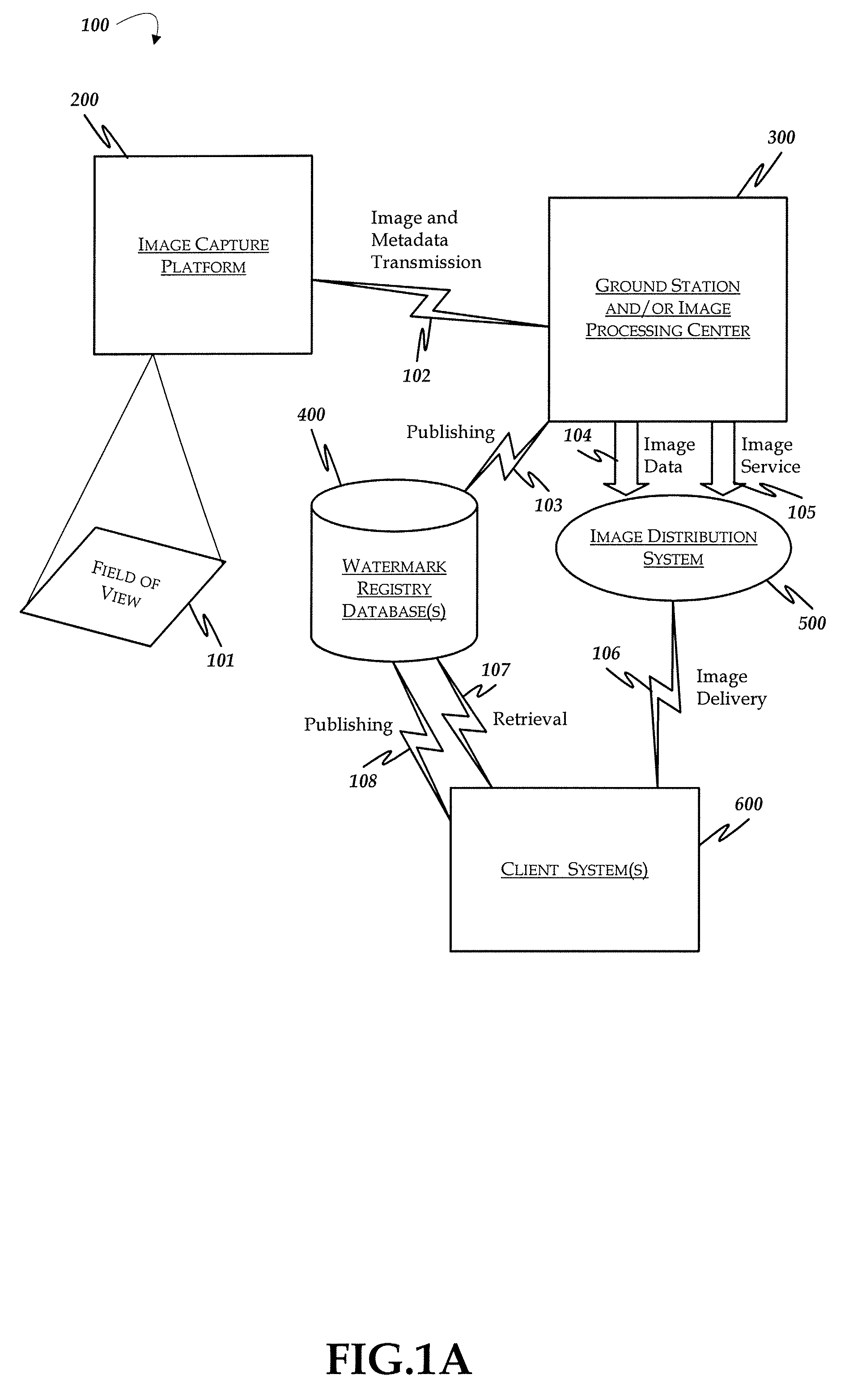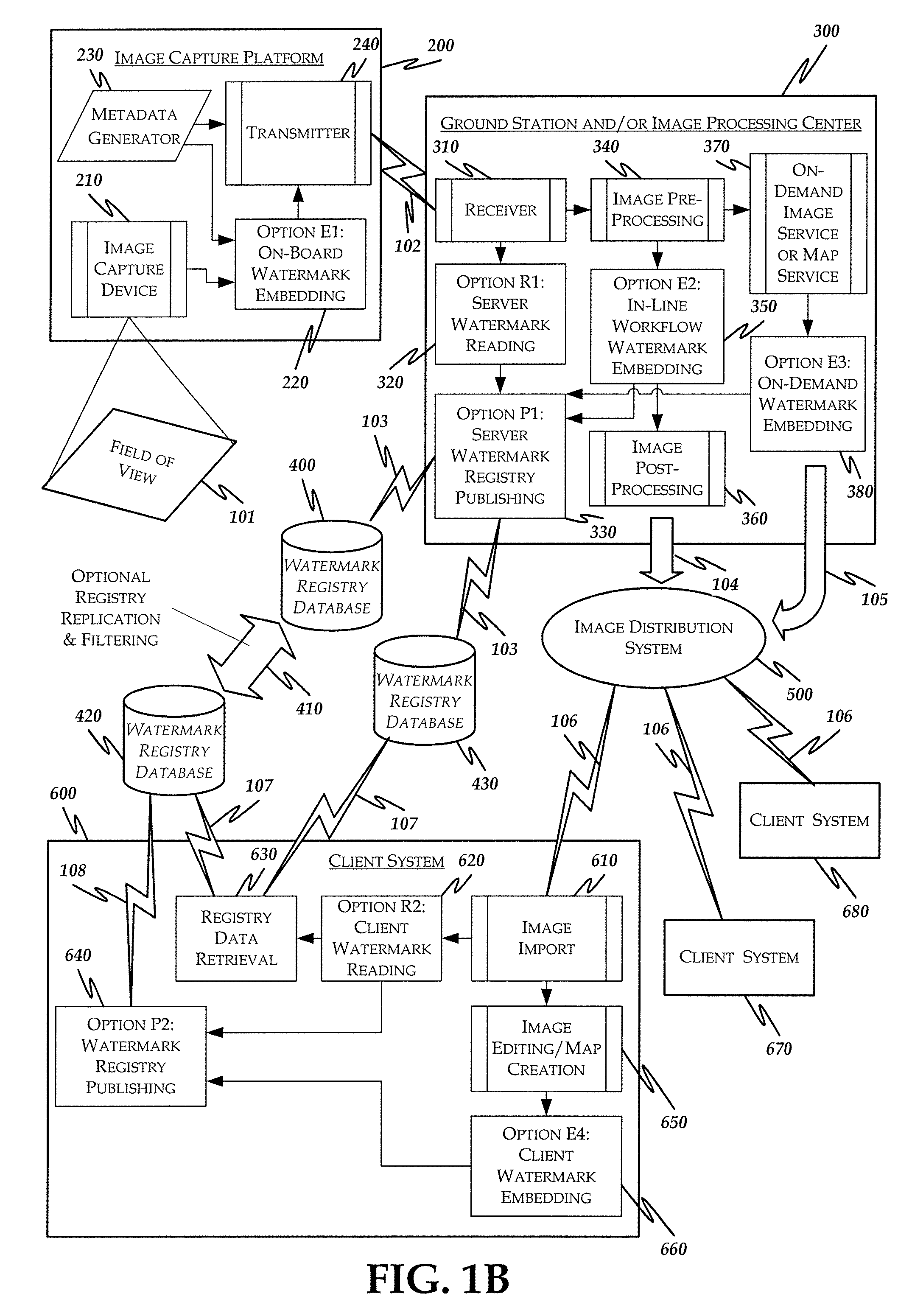Digital Watermarking for Geospatial Images
a geospatial image and digital watermarking technology, applied in the field of digital watermarking of digital images, can solve problems such as inability to detect digital watermarks
- Summary
- Abstract
- Description
- Claims
- Application Information
AI Technical Summary
Benefits of technology
Problems solved by technology
Method used
Image
Examples
example geographic
[0044]FIG. 1A is a system diagram illustrating an example geographic information system (100) that is arranged in accordance with at least some aspects of the present disclosure. The geographic information system (100) includes an image capture platform (200), a ground station and / or image processing center (300), watermark registry database(s) (400), an image distribution system (500) and client system(s) (600).
[0045] The image capture platform (200) includes an output that is coupled to an input of the image ground station and / or processing center (300). The image processing center (300) is arranged in communication with the watermark registry database (400) and the image distribution system (500). Both the watermark registry database(s) (400) and the image distribution system (500) are also in communication with one or more client systems (600).
[0046] In operation, the image capture device (600) is arranged to capture an image from a scene that is located with...
example signal
Flow
[0052]FIG. 2A diagrams an example signal flow for the image capture platform (200) where images are captured and an on-board watermark is added to the image. Within this block, the image signal (101) is captured by the digital imaging device (210) and passed (201) to the on-board watermark embed process (220). Meanwhile, on-board sensors (231) are collecting real-time metadata related to the imaging platform such as date, time, location, direction and speed of travel, field of view, type of image data collected, height, and width. The sensor data (233) is formatted (232) and passed to both the on-board embed process (220) and the transmitter (240). Within the on-board watermark embed process (220), the payload data (202) from the metadata generator (230) is combined with source and image identifiers in a variable payload formatting process (221). This process determines the type of payload to embed based on system configurations and the amount of data available. The formatted pa...
example process
Flow
[0064]FIG. 7 is a process flow diagram (700) illustrating a geospatial digital watermarking workflow that is arranged in accordance with at least some aspects of the present disclosure. Process flow diagram 700 includes processing blocks 701-713.
[0065] At processing block 701, a source image frame is captured such as from an image capture device illustrated in FIG. 2B. Proceeding to block 702, the source image is pre-processed as illustrated in FIG. 3B to prepare the image for downstream processes like mosaicing. In other cases, the image could be retrieved from internal storage at an image processing center. These processes could include orthorectification, radiometric balancing, or other processes. Continuing to block 703, a process is applied to determine the type and format of payload to use in the image (also called the payload definition). This process can be dependent on system configuration settings, environmental settings, the amount of metadata available and other par...
PUM
 Login to View More
Login to View More Abstract
Description
Claims
Application Information
 Login to View More
Login to View More - R&D
- Intellectual Property
- Life Sciences
- Materials
- Tech Scout
- Unparalleled Data Quality
- Higher Quality Content
- 60% Fewer Hallucinations
Browse by: Latest US Patents, China's latest patents, Technical Efficacy Thesaurus, Application Domain, Technology Topic, Popular Technical Reports.
© 2025 PatSnap. All rights reserved.Legal|Privacy policy|Modern Slavery Act Transparency Statement|Sitemap|About US| Contact US: help@patsnap.com



